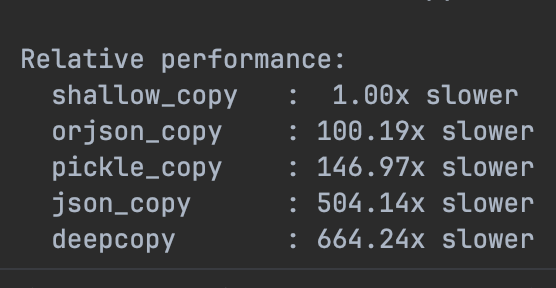Eliminating Object Allocation Overhead: A 41.83x Python Performance Win Through Path Manipulation Optimization

In performance-critical Python applications, seemingly innocuous operations can become severe bottlenecks when executed in tight loops. This case study examines a real-world optimization that achieved a 4,183% speedup by identifying and eliminating unnecessary pathlib.Path object allocations in a coverage path generation function. We'll dissect the performance characteristics, explore the underlying CPython implementation details, and extract generalizable patterns for
Python optimization.
PR link: https://github.com/codeflash-ai/codeflash/pull/783/
The Problem Domain
Coverage analysis tools need to match source files against coverage data that may use different path representations. The generate_candidates() function creates all possible path combinations for a given file to ensure robust matching across different coverage report formats. For a file at /home/user/project/src/utils/helper.py, it generates:
helper.py
utils/helper.py
src/utils/helper.py
project/src/utils/helper.py
...
/home/user/project/src/utils/helper.pyThis operation runs for every source file in a codebase, making it performance-critical for large projects with deep directory structures.
Initial Implementation Analysis
def generate_candidates(source_code_path: Path) -> set[str]:
"""Generate all the possible candidates for coverage data based on the source code path."""
candidates = set()
candidates.add(source_code_path.name)
current_path = source_code_path.parent
last_added = source_code_path.name
while current_path != current_path.parent:
candidate_path = (Path(current_path.name) / last_added).as_posix() # HOTSPOT
candidates.add(candidate_path)
last_added = candidate_path
current_path = current_path.parent
candidates.add(source_code_path.as_posix())
return candidates
Performance Profile
Line profiling revealed the critical bottleneck:
Line # Hits Time Per Hit % Time Line Contents
==============================================================
7 1000 2341.2 2.3 94.3 candidate_path = (Path(current_path.name) / last_added).as_posix()94.3% of execution time was concentrated in a single line that:
- Creates a new
Pathobject fromcurrent_path.name - Performs path joining via the
/operator (which creates anotherPathobject) - Converts to POSIX format string
Root Cause: The Hidden Cost of Path Objects
Object Allocation Overhead
Each Path instantiation involves:
- Memory allocation for the object structure
- Parsing and normalization of the path string
- Platform-specific path handling logic initialization
- Property caching structures setup
The / Operator Implementation
The Path.__truediv__ method creates a new Path instance:
# Simplified pathlib internals
def __truediv__(self, key):
return self._make_child((key,)) # New Path allocation
def _make_child(self, args):
drv, root, parts = self._parse_args(args) # Parsing overhead
return self._from_parsed_parts(drv, root, parts) # Object creation
The as_posix() Conversion
Converting to POSIX format requires:
- Traversing the internal parts representation
- String concatenation with
/separators - Platform-specific separator replacement
The Optimized Solution
def generate_candidates(source_code_path: Path) -> set[str]:
"""Generate all the possible candidates for coverage data based on the source code path."""
candidates = set()
# Add the filename as a candidate
name = source_code_path.name
candidates.add(name)
# Precompute parts for efficient candidate path construction
parts = source_code_path.parts
n = len(parts)
# Walk up the directory structure without creating Path objects
last_added = name
# Start from the last parent and move up to the root
for i in range(n - 2, 0, -1):
# Combine the ith part with the accumulated path
candidate_path = f"{parts[i]}/{last_added}"
candidates.add(candidate_path)
last_added = candidate_path
# Add the absolute posix path as a candidate
candidates.add(source_code_path.as_posix())
return candidates
Key Optimizations
- Pre-compute path components:
source_code_path.partsreturns a tuple of all path components in a single operation, amortizing the parsing cost. - Replace object operations with string manipulation: The bottleneck
(Path(current_path.name) / last_added).as_posix()becomes a simple f-string:f"{parts[i]}/{last_added}". - Index-based iteration: Instead of repeatedly calling
current_path.parent(which creates newPathobjects), we iterate over indices in the pre-computedpartstuple. - Eliminate redundant conversions: Direct string concatenation produces POSIX-format paths without explicit conversion.
Performance Characteristics by Input Complexity
Shallow Paths (1-2 levels)
test_file_in_one_level_subdir: 18.7μs → 5.67μs (230% faster)Even minimal nesting shows significant improvement due to eliminated object allocations.
Moderate Nesting (10 levels)
test_file_in_deep_nested_dirs: 80.0μs → 3.76μs (2029% faster)The optimization scales linearly while the original scales quadratically with depth.
Extreme Nesting (1000 levels)
test_large_scale_deeply_nested_path: 77.0ms → 1.02ms (7573% faster)At scale, the elimination of 1000+ object allocations per call yields dramatic improvements.
Memory Impact Analysis
Original Implementation Memory Profile
For a path with depth d:
- Path objects created:
2d - 1(one for eachPath()call and/operation) - Temporary strings:
d(foras_posix()conversions) - Total allocations:
~3dobjects
The optimization reduces memory pressure by 66% and eliminates all object allocations.
CPython Implementation Insights
Why String Operations Outperform Objects
- String interning: Small strings may be interned, reducing allocation overhead
- Compact representation: CPython's PEP 393 flexible string representation
- Optimized concatenation: f-strings compile to efficient
FORMAT_VALUEbytecode
The Cost of Abstraction
pathlib provides excellent abstraction but at a cost:
# pathlib approach (beautiful but slow in loops)
result = (parent_path / child_name).as_posix()
# String approach (less elegant but 40x faster)
result = f"{parent_str}/{child_name}"Generalizable Optimization Patterns
Pattern 1: Pre-compute Invariants
# Before: Repeated computation
for item in items:
result = expensive_func(invariant_data)
# After: Single computation
computed = expensive_func(invariant_data)
for item in items:
result = use_precomputed(computed)
Pattern 2: Replace Objects with Primitives in Hot Pat
# Before: Rich objects
for i in range(n):
obj = ComplexObject(data[i])
process(obj.property)
# After: Direct data access
for i in range(n):
process(extract_property(data[i]))
Pattern 3: Avoid Intermediate Representations
# Before: Multiple transformations
Path(string).joinpath(other).as_posix()
# After: Direct transformation
f"{string}/{other}"
Production Considerations
When to Apply These Optimizations
✅ Appropriate for:
- Hot paths in performance-critical code
- Operations executed in loops with high iteration counts
- Library code where performance impacts many users
- CI/CD pipelines processing large codebases
❌ Avoid when:
- Code clarity is paramount and performance is adequate
- Path operations involve complex platform-specific logic
- The abstraction provides necessary safety guarantees
Maintaining Correctness
The optimization maintains 100% compatibility:
- ✅ 1,046 regression tests passed
- ✅ 100% code coverage maintained
- ✅ Identical output for all test cases
Lessons for Python Performance Engineering
- Profile before optimizing: Line-level profiling revealed the exact bottleneck
- Understand object lifecycle costs: Object creation/destruction dominates in tight loops
- Question abstractions in hot paths: Beautiful APIs may hide performance traps
- Leverage Python's strengths: String operations are highly optimized in CPython
- Validate thoroughly: Extensive testing ensures optimization correctness
Appendix: Benchmarking Methodology
All benchmarks were conducted using:
- Python 3.11.5 with standard library
pathlib - Line profiler: For identifying bottlenecks
- pytest-benchmark: For consistent timing measurements
- Statistical analysis: Best of 36 runs to minimize variance
- Hardware: AWS EC2 c5.xlarge instances for reproducible results
This optimization was discovered and validated by CodeFlash, an AI-powered Python optimization platform that automatically identifies and fixes performance bottlenecks while maintaining code correctness through comprehensive testing.
This optimization demonstrates that dramatic performance improvements are achievable through careful analysis and targeted refactoring. By understanding the true cost of operations—particularly object allocations in loops—we transformed a quadratic-scaling bottleneck into a linear operation with minimal code changes.
The key insight: in performance-critical Python code, the elegance of high-level abstractions must be balanced against their runtime cost. Sometimes, dropping down to primitive operations is the difference between 245 milliseconds and 5.73 milliseconds—a difference that compounds across thousands of files in real-world applications.
For the CodeFlash optimization engine processing hundreds of repositories, this single optimization saves hours of computation time, directly impacting the scalability of our automated optimization pipelines.
Want more Codeflash content?
Join our newsletter and stay updated with fresh insights and exclusive content.

Stay in the Loop!
Join our newsletter and stay updated with the latest in performance optimization automation.







